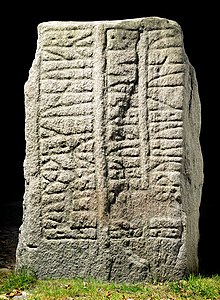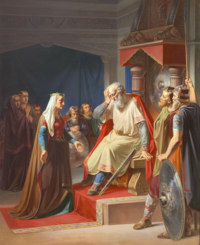Thyra
| Thyra | |
|---|---|
 The Jelling 1 stone, commissioned by Thyra's husbandGorm the Oldto commemorate her. | |
| Queen consort of Denmark | |
| Died | Likely before 963 CE. See§ Death and burial |
| Spouse | Gorm the Old |
| Issue | |
| House | House of Gorm |
| Father | PossiblyÆthelred I of WessexorKlak Harald |
Thyra(Old Norse:ÞyriorÞyre) was the wife of KingGorm the OldofDenmark,and one of the firstqueens of Denmarkwidely believed by scholars to be historical rather than legendary. She is presented inmedievalsources as a wise and powerful woman who ordered the building or fortification of theDanevirke,consistent with her commemoration on multipleViking Agerunestones.These include those atJellingwhich was the seat of power for her dynasty. When she was born and became queen is unclear, however, she likely ruled until her death in the middle of the 10th century CE.
Name
[edit]Thyra's name is attested in Old Norse as Þyri and Þyre and has been alternatively anglicised as Thorvi and Thyre.[1][2][3]
The Jelling 1 stone, commissioned in honour of Thyra by her husband after her death refers to her asDanmarkar bót,translating as "Denmark's adornment", "strength", "salvation" or "remedy".[4][5]It has been further argued that the wordsDanmarkar bótinstead refer to Gorm, with Thyra's importance being a later innovation by medieval writers, though this is not the scholarly consensus.[4][6]This term is also used to describe her inSaga Hálfdanar svartaasDanmarkar bótar(sometimes anglicised as "Dannebod" ).[1]
Family
[edit]Early life
[edit]
Thyra's parentage is unclear and is attested differently in different sources.Saxo Grammaticusdescribes her as the daughter of the English king Ethelred.[4][7]This king has typically been identified asÆthelred I of Wessex,though alternatives includeEdward the Elder.[8]If Thyra was actually the daughter of Æthelred, the invasion of England bySweyn Forkbeardcould be more accurately depicted as a succession crisis, with the descendants of Thyra having a stronger claim to the throne than the children ofAlfred the Great.[4][9]
An alternative proposal given by accounts such asHeimskringlaandJómsvíkinga sagais that her father wasKlak Harald,anearlwho ruled over a region in the area aroundJutland.Heimskringla further says that Thyra's sister was Þorní, the wife ofSigurðr hjörtrand grandmother ofHarald Fairhair.[10]Based on the account in Jómsvíkinga saga, it has been proposed that Thyra was born around 806-812 CE and married Gorm around 825 CE. Jómsvíkinga saga further describes Thyra as having two sons with Gorm, Canute andHaraldand that Harald eventually killed Canute. It has been noted though that Klak Harald died in 846 CE, while Harald Bluetooth died around 986 CE. Based on other dating such as the possible birth years of Thyra's other children, it has been argued that Thyra, the wife of Gorm the Old, could not have been the daughter of Klak Harald, with the lengths of time between her children's births being too great.[11]
Marriage and children with Gorm the Old
[edit]
Gesta Danorum
[edit]Gesta Danorum describes that Thyra stood out as a serious and cunning woman and said that she would not marry Gorm until she had all of Denmark as her dowry. When this was agreed, she was betrothed to him but asked him not to have sex with her when they shared a bed for the first three nights until she had had a vision that their marriage would go well. Gorm agreed and laid a drawn sword between them in the bed, and at night he dreamed that a large bird and a smaller one flew out of his wife's womb and flew up into the sky and sat on each of his hands. Again they flew off and came back but the third time when they flew away, only the smaller bird came back and its wings were covered in blood. At this, Gorm woke and cried out, telling his vision to his servants and Thyra took it to mean that they would have children together. This later happened when she gave birth to Canute and Harald.[12]
Jómsvíkinga saga
[edit]According to Jómsvíkinga saga, before Thyra married Gorm, she was already working closely with Klak Harald in the running of his kingdom. Gorm at the time was ruling a kingdom in the north of Jutland and asked her for marriage and threatened to take her by force if she did not go willingly. Neither accepting nor rejecting her offer, she told him that to work out if they would have a happy marriage, he had to build a house in a wood that could fit only one bed and to sleep there alone for three nights, telling her what dreams he had. Gorm did this, setting his men to watch the house and had three dreams. In the first dream, three whiteboarscame out of the sea, fed on the grass, and went back to the sea. In the next, three red boars with large tusks came out of the sea, and did the same. In the third dream, three black boars with even larger tusks did the same, but when they returned to the sea, there was such a loud rush of the waves returning to the land that he thought the noise could be heard throughout Denmark.[13]
Thyra's interpretation was that the three white boars represented three very cold, snowy winters that would harm crops. The red boars were interpreted to mean that three mild winters would follow, while the black boars meant there would be wars in the land. The fact that all of the boars went back into the sea showed that their effects would not be long-lasting. The loud noise as the waves of the sea rolled back on the Danish shores signified that mighty men would come to the land and Gorm's relations would be drawn into the wars that would follow. She said that had he dreamed of the black boars and the rushing waves the first night, she would not have married him, but since she would be available to provide advice as queen, there would be little injury from the wars foretold.[13]
Historia Norwegiæ
[edit]TheHistoria Norwegiærecords that Thyra was the mother ofGunnhildr konungamóðirwith her husband and contrasts her astuteness with the foolishness of Gorm.[14]
Runestones
[edit]
The Jelling 2 stone records that Thyra and Gorm the Old hadHarald Bluetoothas a child. This is widely accepted as historically accurate by scholars.[4]Based on the prominence of Thyra seen in the runestone record, it has been proposed that Thyra may have been of the preexisting royal line and that Gorm became king through marriage with her.[5]
Dating
[edit]Gorm became king around 936 CE however when Thyra became queen is not well understood.[4]
Runestones
[edit]Along with tworunestonesat the royal site ofJellingdating to the mid 10th century CE, the name Thyra is recorded on five more fromViking Age Denmark-Laeborg (DR 26),Bække1 and 2 (DR 29 and 30), Horne (DR 34) and Randbøl (DR 40). Although all seven stones reference a woman called Thyra, it has been debated whether they refer to the same person.[4]
It has been proposed however, based on analysis of factors such as groove depth, rune shape and spelling, that a single runecarver namedRavnunge-Tue(who is one of the earliest known Western European artisans to have carved his name on his work as the maker) wrote the inscriptions both on the Læborg and Jelling 2 stones, while another individual carved the Horne, Bække and possibly the Randbøl stones. From this, it has been argued that the Jelling stones, the Læborg stone and Bække 1 commemorate the same woman named Thyra. If correct, she would be recorded on at least four runestones - the most for anyone in Viking Age Denmark, exceeding both Gorm the Old and Harald Bluetooth. Following this, it has been suggested that she was either one of the individuals or even the leading figure who drove the assembly of the Danish kingdom.[4]
Strengthening of the Danework
[edit]Both Aggesen andSaxo Grammaticusrecord that Thyra was a wise and steadfast queen who ordered the building of theDanework,an earthwork built to protect Denmark from invaders from the south.[4] Though the first phase of construction of the fortifications predates Thyra's reign, with some trees in the fortification having been felled in 737 CE, they were extended significantly several times until the 12th-century CE.[15][16]
Death and burial
[edit]
The northernhoweat Jelling, the seat of power for Gorm's dynasty, is traditionally known asThyras Høj( "Thyra's mound" ), with the southern as Gorm's, although when excavated, no evidence of a body was found in it. Wooden artefacts from the howe have however been dated bytree-ring analysisto 959-960 CE which would put this as the latest date for Thyra's death if it is indeed her grave.[4][17][18]
It has been proposed that her burial in the larger, northern barrow is consistent with the idea of her as a prominent woman who may have been even more powerful than her husband Gorm.[4]
Gorm died around 963 CE and while Saxo records in Gesta Danorum that Thyra died after her husband, it is typically believed that Thyra died before Gorm due to the Jelling 1 stone which he raised to commemorate her.[19][20]
Modern influences
[edit]- Asteroid115 Thyrais named after her.[citation needed]
- Danebod,a district in Minnesota in the USA[21]
Gallery
[edit]-
"Thyra Danebod tries to appease Gorm the Old's anger against some captive Christians" byJulius Exner,1849.
-
"Thyra Dannebod establishes the Danevirke" byLorenz Frølich,1855.
-
"Thyra establishes the Danevirke" byLouis Moe,1898.
See also
[edit]References
[edit]- ^abSaga Hálfdanar svarta,Chapter 5.
- ^Jómsvíkíngasaga,Chapter 2.
- ^Sawyer 2000,p. 158.
- ^abcdefghijkImer, Åhfeldt & Zedig 2023.
- ^abRandsborg 2008,p. 15.
- ^Hollander 1928,pp. 111–112.
- ^Rason 1913–1914,p. 285.
- ^Rason 1913–1914,p. 292.
- ^Rason 1913–1914,p. 294.
- ^Rason 1913–1914,pp. 285–287.
- ^Rason 1913–1914,pp. 290–291.
- ^Gesta Danorum,pp. 673–677.
- ^abRason 1913–1914,pp. 287–289.
- ^Historia Norwegiæ,15/7.
- ^National Museum of Denmark(Nationalmuseet).The Danish collection: prehistoric period: Guide for visitors,para. 367 (Thiele 1908, translated by G. Auden).
- ^Bregnsbo & Jensen 2022.
- ^abWhitbread 1967,p. 34.
- ^Randsborg 2008,pp. 8–9.
- ^Lund 2020,p. 147.
- ^Randsborg 2008,pp. 7.
- ^Upham 2001,p. 330.
Bibliography
[edit]Primary
[edit]- Saxo Grammaticus.Gesta Danorum[Deeds of the Danes] (in Latin).
- Friis-Jensen, Karsten, ed. (2015).Gesta Danorum: The History of the Danes.Translated by Fisher, Peter. Oxford: Oxford University Press.ISBN9780198205234.
- Jómsvíkíngasaga[Saga of the Jomsvikings] (in Old Norse).
- "Jómsvíkíngasaga".www.heimskringla.no(in Old Norse).Retrieved15 October2023.
- Sturluson, Snorri."Saga Hálfdanar svarta" [Saga of Halfdan the Black].Heimskringla(in Old Norse).
- "Saga Hálfdanar svarta".www.heimskringla.no(in Old Norse).Retrieved15 October2023.
- "Halfdan the Black Saga".sacred-texts.Retrieved22 October2023.
- Historia Norwegiæ[History of Norway] (in Latin).
- Phelpstead, Carl, ed. (2001).History of Norway and the Passion and Miracles of the Blessed Óláfr(PDF).Vol. 13. Translated by Kunin, Devra. University College London: Viking Society for Northern Research.ISBN978 0 903521 48 2.
Secondary
[edit]- Bregnsbo, Michael; Jensen, Kurt Villads (2022)."The Christian Empire of the North Sea".The Rise and Fall of the Danish Empire.Springer International Publishing: 25–49.doi:10.1007/978-3-030-91441-7_3.ISBN978-3-030-91440-0.
- Hollander, Lee M. (1928)."Queen Thyra Danmarkarbót".Scandinavian Studies and Notes.10(4): 111–114.ISSN1544-2063.JSTOR40915261.
- Imer, Lisbeth M.; Åhfeldt, Laila Kitzler; Zedig, Henrik (2023)."A lady of leadership: 3D-scanning of runestones in search of Queen Thyra and the Jelling Dynasty".Antiquity.97(395): 1262–1278.doi:10.15184/aqy.2023.108.ISSN0003-598X.
- Lund, Niels (2020).Jellingkongerne: og deres forgængere.Roskilde: Vikingeskibsmuseet i Roskilde.ISBN978-87-85180-75-9.
- Randsborg, Klavs (16 April 2008)."Kings' Jelling: Gormormorm & Thyrahyrahyrahyra's Palace Harald's Monument & Grave - Svend's Cathedral".Acta Archaeologica.79(1): 1–23.doi:10.1111/j.1600-0390.2008.00107.x.ISSN0065-101X.
- Rason, Ernest (1913–1914)."Thyra, the Wife of Gorm the Old: Was She English or Danish?"(PDF).Saga-Book of the Viking Society.8:288.Retrieved22 November2016.
- Sawyer, Birgit (2000).The Viking-age Rune-stones: Custom and Commemoration in Early Medieval Scandinavia.Oxford University Press.ISBN978-0-19-820643-9.
- Upham, Warren (2001).Minnesota Place Names: A Geographical Encyclopedia.Minnesota Historical Society Press.ISBN978-0-87351-396-8.
- Whitbread, L. (1967).""BEOWULF" AND ARCHAEOLOGY: Two Footnotes ".Neuphilologische Mitteilungen.68(1): 28–35.ISSN0028-3754.JSTOR43342324.



